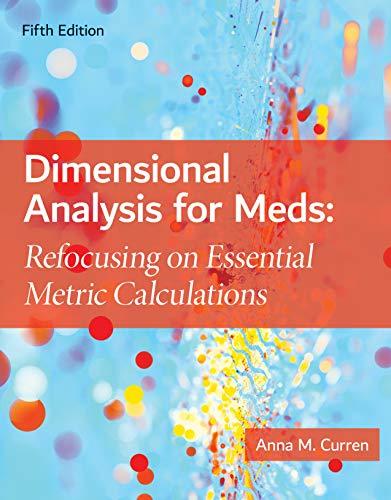
https://ebookmass.com/product/dimensional-analysis-formeds-5th-edition-ebook-pdf/



https://ebookmass.com/product/dimensional-analysis-formeds-5th-edition-ebook-pdf/

https://ebookmass.com/product/a-call-for-kelp-bree-baker/
ebookmass.com
Mortal Music Ann Parker
https://ebookmass.com/product/mortal-music-ann-parker/
ebookmass.com
(eBook PDF) Fit & Well: Core Concepts and Labs in Physical Fitness and Wellness 14th Edition
https://ebookmass.com/product/ebook-pdf-fit-well-core-concepts-andlabs-in-physical-fitness-and-wellness-14th-edition/
ebookmass.com
Ockham's Nominalism Claude Panaccio
https://ebookmass.com/product/ockhams-nominalism-claude-panaccio/




ebookmass.com
Effectiveness of Enterprise Risk Management: Determinants and Opportunities for Improvement
https://ebookmass.com/product/effectiveness-of-enterprise-riskmanagement-determinants-and-opportunities-for-improvement-izabelajonek-kowalska/
ebookmass.com


Anna M. Curren
RN. Royal Victoria Hospital, Montreal, Quebec, Canada
BN. Public Health, Dalhousie University, Halifax, Nova Scotia, Canada
MA. Education Instructional Design, California State University, Long Beach, California
LL.D (Hon). Memorial University of Newfoundland, St. John’s, Newfoundland, Canada
Formerly Associate Professor of Nursing
Long Beach Community College
Long Beach, California
The preface is an introduction written by an author to explain a text’s content. I welcome this opportunity.
The most important content in Dimensional Analysis for Meds begins in Chapter 1 with the Metric System. My personal estimate is that 98% of all dosage calculations involve metric measures. That’s a conservative estimate—the real percentage is probably even higher. By the time the student completes Chapter 10, calculating metric dosages will have become automatic for the learner. In these pivotal 10 chapters, students learn to read oral and parenteral dosage labels, and calculate a wide range of ordered dosages. For parenteral dosages, this includes the measurement of dosages using appropriatesized syringe calibrations.
The Refresher Math needed later for IV calculations using dimensional analysis is presented in Section 2, primarily to reassure learners that they are capable of doing it. Students are referred back to this content for review when they reach the topic of dimensional analysis in Chapter 11, where they will use the math for the first time in IV calculations.
The decision to include dimensional analysis as the ONLY calculation method is quite deliberate. This approach reduces multiple IV factor entries to a single common-fraction equation. Neither ratio and proportion nor the formula method, both of which involve multiple calculation steps, can make this claim and make calculations as easy and reliably correct.
Additional text chapters, primarily on safe medication administration, pediatric dosage calculations based on body weight and body surface area, and other pediatric considerations in medication administration are included, wrapping up this concise 20-chapter text.
Welcome to our journey together through Dimensional Analysis for Meds. Many students have written me over the years to tell me how much they enjoyed learning from my text, and I anticipate you will enjoy it, too.
First things first: Put aside any worry that you have over your math skills. Your admission to your current nursing or technical program guarantees that you have the ability to succeed. Clinical math is NOT complicated, and you WILL be successful. While math lends itself best to a printed text, you can also successfully use an online instructional version.
1. The first requirement is to locate a clear writing surface, and to gather lots of scratch paper, pencils, pens, and a calculator.
2. Record your answers both in the text and on paper, which will make checking multiple answers much easier.
3. Programmed learning proceeds in small steps. Do exactly as the text instructs you to do, and no more. Jumping ahead may cause confusion.
4. All chapters allow you to proceed at your own speed, and you may be surprised at how quickly you move ahead.
5. Keep Dimensional Analysis for Meds in your professional library. You may move to different clinical areas in your career, and a quick refresher of contents may be helpful.
There is nothing quite like finishing a lesson and feeling like you’ve nailed it, and you are going to do just that using this text! So settle down, and enjoy your clinical dosage journey with me.
—Anna M. Curren
Express these numbers to the nearest hundredth.
17. 1.357 =
18. 7.413 =
19. 10.105 =
20. 3.775 =
21. 0.176 =
Multiply these decimals. Express your answers to the nearest tenth.
22. 0.7 × 1.2 =
23. 1.8 × 2.6 =
24. 5.1 × 0.25 × 1.1 =
25. 3.3 × 3.75 =
Divide these fractions. Express your answers to the nearest hundredth.
26. 16.3 ÷ 3.2 =
27. 15.1 ÷ 1.1 =
28. 2 ÷ 0.75 =
29. 4.17 ÷ 2.7 =
Define the following terms.
30. Numerator
31. Denominator
32. Greatest common denominator
Solve these equations. Express your answers to the nearest tenth.
33. 1 4 2 3 3 =
34. 240 170 135 300 3 =

CHAPTER 1 The Metric/SI System
CHAPTER 2 Additional Drug Measures: Units, Percentage, Milliequivalent, Ratio, and Household
5. (a) 4.3 (b) 2.75 (c) 5.1
6. (a) 6.15 (b) 7.4 (c) 5.95
7. (a) 7.25 (b) 8.1 (c) 9.37
8. (a) 4.25 (b) 5.1 (c) 3.75
9. (a) 9.4 (b) 8.75 (c) 7.4
10. (a) 5.1 (b) 6.33 (c) 4.2
If, however, the whole numbers are the same—for example, 10.2 and 10.7—or if there are no whole numbers—for example, 0.25 and 0.35—then the fraction will determine the relative value. Let’s take a closer look at the fractional side of the scale (refer to Figure 1-2).
It is necessary to consider only three figures after the decimal point on the fractional side, because drug dosages measured as decimal fractions do not contain more than three digits, for example, 0.125 mg. Notice that a zero is used to replace the whole number in this decimal fraction and in all dosages that do not contain a whole number.
If a decimal fraction is not preceded by a whole number, a zero is used in front of the decimal point to emphasize that the number is a fraction.
EXAMPLE 4 0.125 0.1 0.45
Look again at Figure 1-2. The numbers to the right of the decimal point represent tenths, hundredths, and thousandths, in that order. When you see a decimal fraction in which the whole numbers are the same, or if there are no whole numbers, stop and look first at the number representing tenths
The fraction with the greater number representing tenths has the greater value.
EXAMPLE 5 0.3 is greater than 0.27
EXAMPLE 6 0.4 is greater than 0.29
EXAMPLE 7 1.2 is greater than 1.19
EXAMPLE 8 3.5 is greater than 3.2
Figure 1-2 0 . 2 8 6 Thousandths Hundredths Tenths Ones (or units) Decimal point
3. (a) 7.5 (b) 6.25 (c) 4.75
4. (a) 0.3 (b) 0.25 (c) 0.35
5. (a) 1.125 (b) 1.75 (c) 1.5
6. (a) 4.5 (b) 4.75 (c) 4.25
7. (a) 0.1 (b) 0.01 (c) 0.04
8. (a) 5.75 (b) 6.25 (c) 6.5
9. (a) 0.6 (b) 0.16 (c) 0.06
10. (a) 3.55 (b) 2.95 (c) 3.7 Answers
Three types of metric measures are in common clinical use: those for length, volume (or capacity), and weight. The basic units of these measures are:
Length: meter
Volume: liter
Weight: gram
Memorize the basic units if you do not already know them.
In addition to the basic units, there are both larger and smaller units of measure for length, volume, and weight. Let’s compare this concept with something familiar. The pound is a unit of weight that we use every day. A smaller unit of measure is the ounce; a larger unit, the ton. However, all of these units measure weight.
In the same way, there are smaller and larger units than the basic meter, liter, and gram. In the metric system, however, there is one very important advantage: All other units, whether larger or smaller than the basic units, have the name of the basic unit incorporated in them. So, when you see a unit of metric measure, there is no doubt what it is measuring: meter—length, liter—volume, and gram—weight.
Identify the metric measures with their appropriate category of weight, length, or volume.
1. milligram
2. centimeter
3. milliliter
4. millimeter
5. kilogram